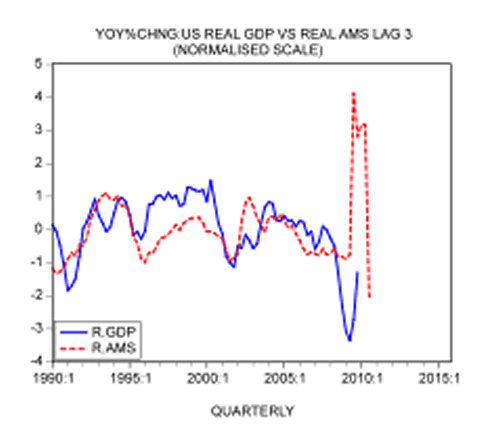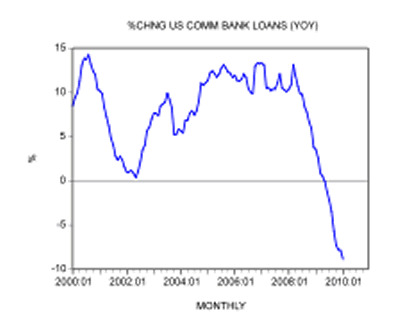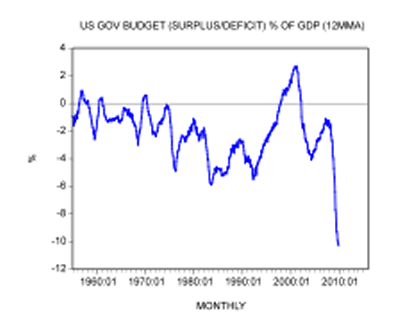The Economic Depression is Not Over
Economics / Great Depression II Feb 10, 2010 - 11:07 AM GMTBy: Frank_Shostak
 Real GDP increased at an annual rate of 5.7% in Q4 after rising by 2.2% in Q3 — the quickest pace in more than six years. This was above Wall Street economists' forecast for a 4.6% increase in Q4. The yearly rate of growth of real GDP climbed to 0.1% in Q4 from −2.6% in Q3. The yearly rate of growth of GDP at current prices, i.e., nominal GDP increased by 0.8% in Q4 from −2.1% in the prior quarter.
Real GDP increased at an annual rate of 5.7% in Q4 after rising by 2.2% in Q3 — the quickest pace in more than six years. This was above Wall Street economists' forecast for a 4.6% increase in Q4. The yearly rate of growth of real GDP climbed to 0.1% in Q4 from −2.6% in Q3. The yearly rate of growth of GDP at current prices, i.e., nominal GDP increased by 0.8% in Q4 from −2.1% in the prior quarter.
 The bounce in the growth momentum of both real and nominal GDP is due to the Fed's massive money expansion. However, a sharp fall in the growth momentum of real AMS[1] poses a threat to the growth momentum of GDP in quarters ahead.
The bounce in the growth momentum of both real and nominal GDP is due to the Fed's massive money expansion. However, a sharp fall in the growth momentum of real AMS[1] poses a threat to the growth momentum of GDP in quarters ahead.


Most economists, including the White House chief economist Christina Romer, hailed the Q4 GDP data as "the most positive news to date on the economy."
But economic growth presented in terms of GDP just describes monetary expenditure. GDP is designed along the line of Keynesian thinking, which holds that spending equates with income — hence more spending leads to a higher national income and in turn to higher economic growth. On this logic, a tighter monetary stance by the Fed leads to slower economic growth while increases in monetary pumping produce higher economic growth. (In the GDP framework, money expansion leads to an increase in overall income in the economy, and hence to a higher rate of growth of GDP).
In reality the exact opposite actually takes place — printing more money weakens wealth generators' ability to grow the economy whilst a decline in the money supply's rate of growth strengthens their ability to grow the economy.
Once the central bank raises the pace of money expansion in order to lift the economy out of a recession, it prevents the demise of various false activities. It also gives rise to new false activities. The outcome of such so-called economic growth is nothing more than the strengthening of wealth consumers and renewed pressure on wealth generators. All this undermines the process of wealth generation and weakens true economic growth.
Real Savings Fund Economic Activity
Irrespective of whether an activity is productive or nonproductive, it must be funded. At any point in time, the number and the size of activities that can be undertaken is determined by the available amount of real savings.
From this we can infer that the overall rate of increase in productive and nonproductive activities as a whole is set by the rate of expansion in the pool of real savings. This inference runs contrary to the GDP framework, where the pace of money pumping sets economic growth.
After all, individuals, whether in productive or nonproductive activities, must have access to real savings in order to sustain their lives and well-beings. Money cannot sustain individuals — it can only fulfill the role of the medium of exchange.
As long as wealth producers can generate enough real wealth to support productive and nonproductive activities, loose-money policies will appear to be successful.
Over time a situation can emerge where, as a result of persistent loose monetary and fiscal policies, there are not enough wealth generators left. Consequently, generated real savings are not large enough to support an increase in economic activity.
Once this happens, the illusion of loose monetary and fiscal policies is shattered; real economic growth must come under pressure. Even in terms of GDP, it will be difficult to show economic growth. (The only way, in such an event, that GDP could grow is through the use of misleading price deflators).
As a rule, monetary pumping by the Fed "works" through the commercial banks' expansion of credit — the increase in commercial bank reserves on account of the Fed's pumping gets amplified by means of credit expansion.
At present, banks are finding it more attractive to sit on massive piles of cash reserves rather than lend them out. In January 2010, excess bank reserves stood at $1.063 trillion, against $793 billion in January 2009 and $1.4 billion in January 2008.
The banks are still in the process of trying to fix their balance sheets. Also, they can't find many viable borrowers, i.e., wealth generators. All this raises the likelihood that the process of wealth formation is in trouble.
Note that if the pace of wealth generation were rising, banks would have been very active in securing a growing slice of the expanding real wealth for themselves. The latest data indicates that banks are still very tight. Year-on-year, in January commercial bank lending fell by 8.8%, and in December it fell by 7.9%. This was the 9th consecutive monthly decline.


If the supply of real savings is dwindling, the government's attempt to boost the rate of growth of GDP by raising expenditures is also going to fail. After all, government activities also require real savings. If the government persists with its aggressive stance, it will only make things much worse: it will deprive funding from wealth-generating activities.
Increasing government outlays while the pool of real savings is declining could severely damage the process of real-wealth formation. Those commentators who subscribe to the view that an increase in government spending can fix things hold that something can be created out of nothing.
There is no such thing as a stimulus policy that can grow the economy. Neither the Fed nor the government can grow the economy. All that stimulatory policies can do is redistribute real savings from wealth-productive to nonproductive activities. These policies encourage consumption that is not supported by useful production.
The latest data show that in Q4 the government outlays to GDP ratio stood at 0.25. Note that the ratio is on an explosive path. Also, the government deficit as a percentage of GDP increased further in December. The 12-month moving average of this percentage stood at 10.3% against 10.1% in November and 4.7% in December 2008.


Conclusion
US real GDP increased at an annual rate of 5.7% in Q4 — the fastest pace in more than six years. The yearly rate of growth climbed to 0.1% in Q4 from −2.6% in Q3. We suggest that the current bounce in the growth momentum of real GDP is on account of the Fed's past massive money pumping. A sharp fall in the current growth momentum of AMS poses a threat to economic growth in terms of GDP in quarters ahead.
We suggest that what matters for true economic growth is the pool of real savings. There is a growing likelihood that this pool might be in trouble. An important factor that provides support for this conclusion is the continuous fall in bank lending.
A further attempt by the federal government to "help" the economy with fiscal stimulus is only likely to further weaken the pool of real savings. This will make it much harder for the economy to stage a meaningful recovery.
Frank Shostak is an adjunct scholar of the Mises Institute and a frequent contributor to Mises.org. He is chief economist of M.F. Global. Send him mail. See his article archives. Comment on the blog.![]()
© 2005-2022 http://www.MarketOracle.co.uk - The Market Oracle is a FREE Daily Financial Markets Analysis & Forecasting online publication.



